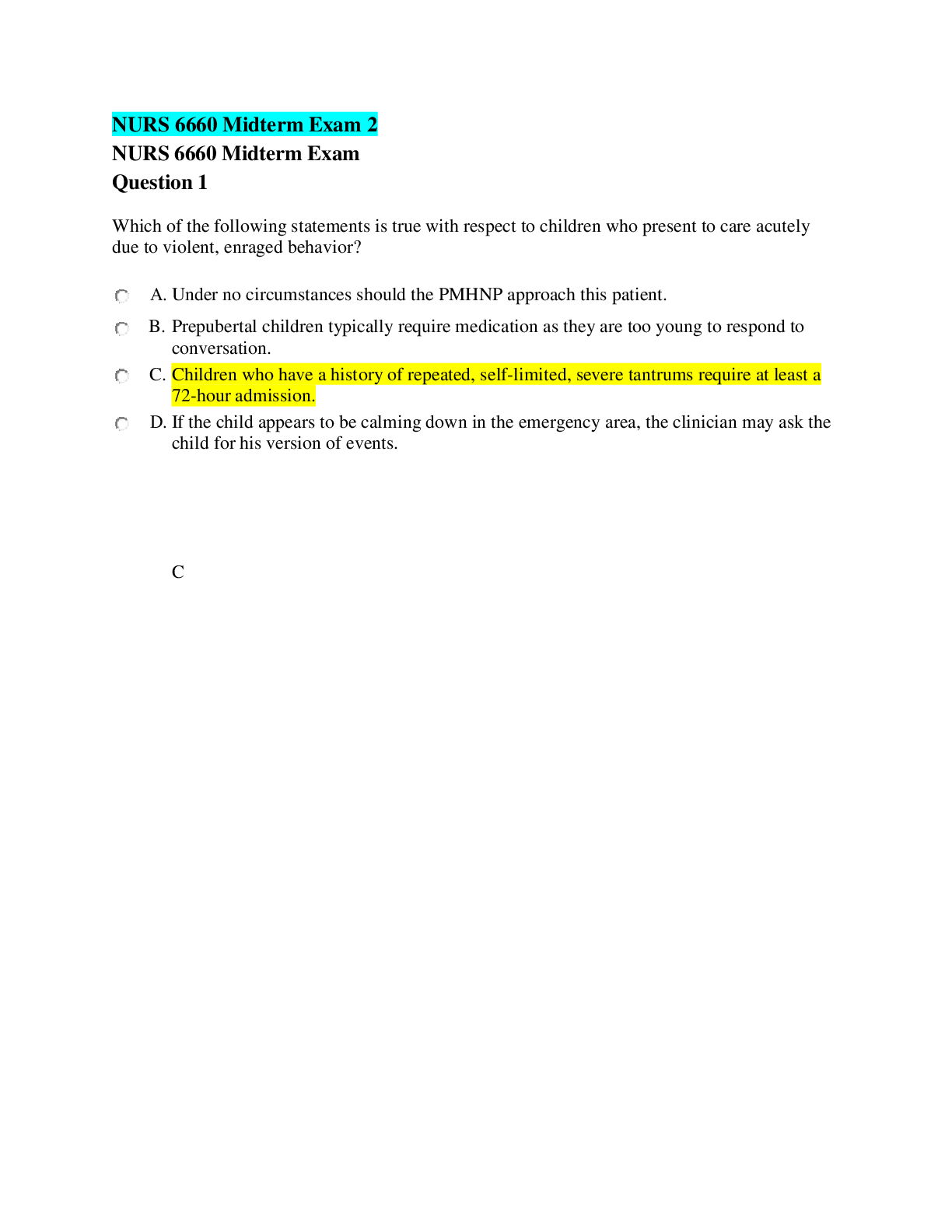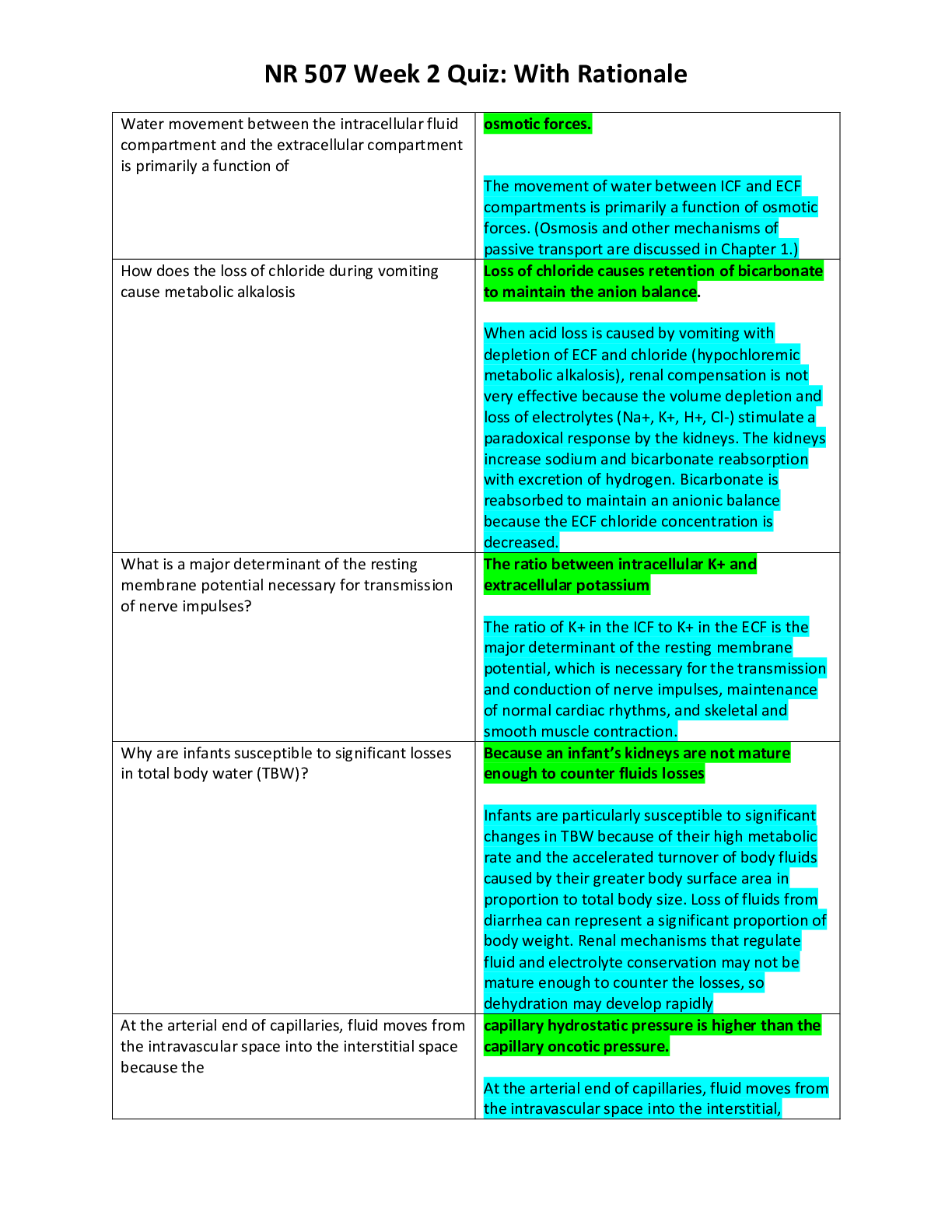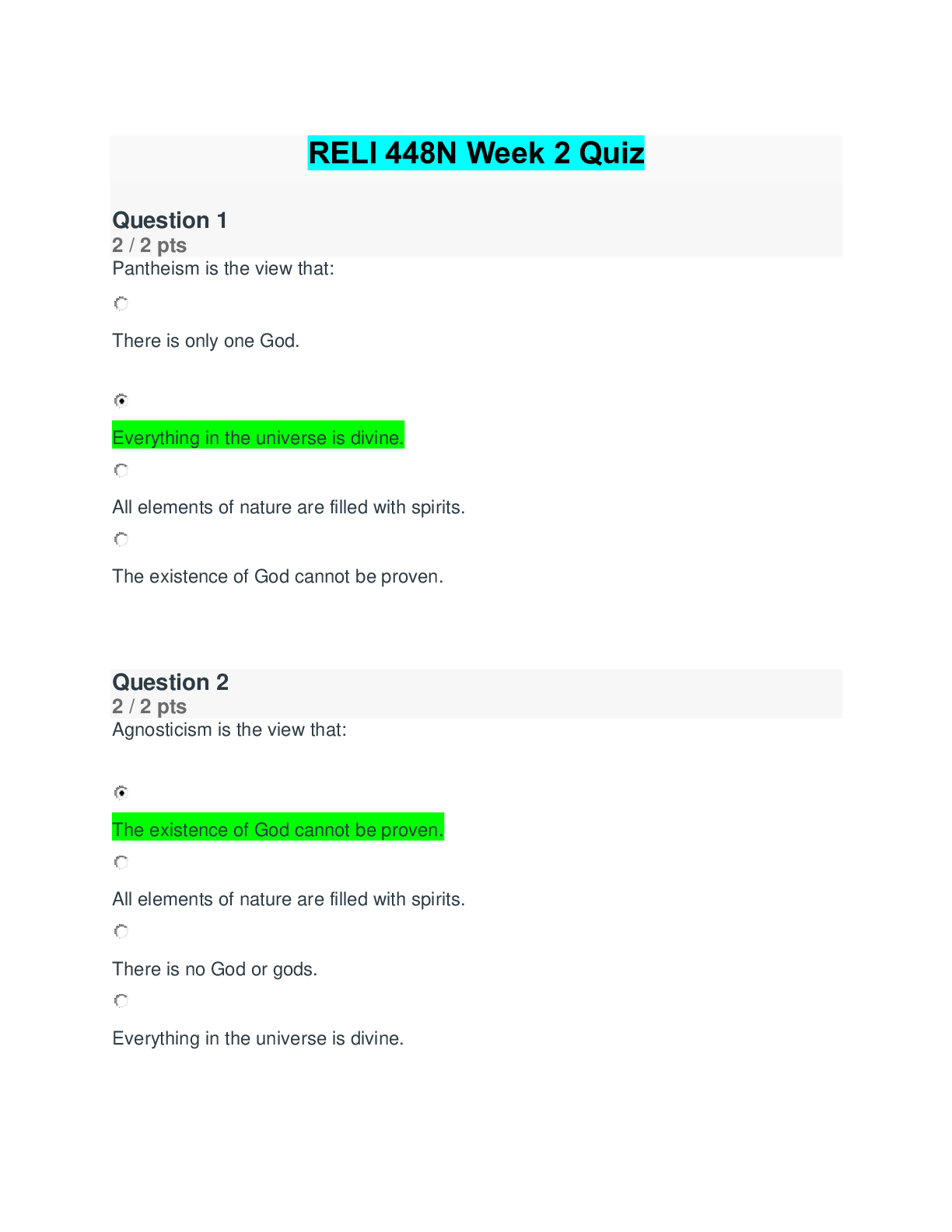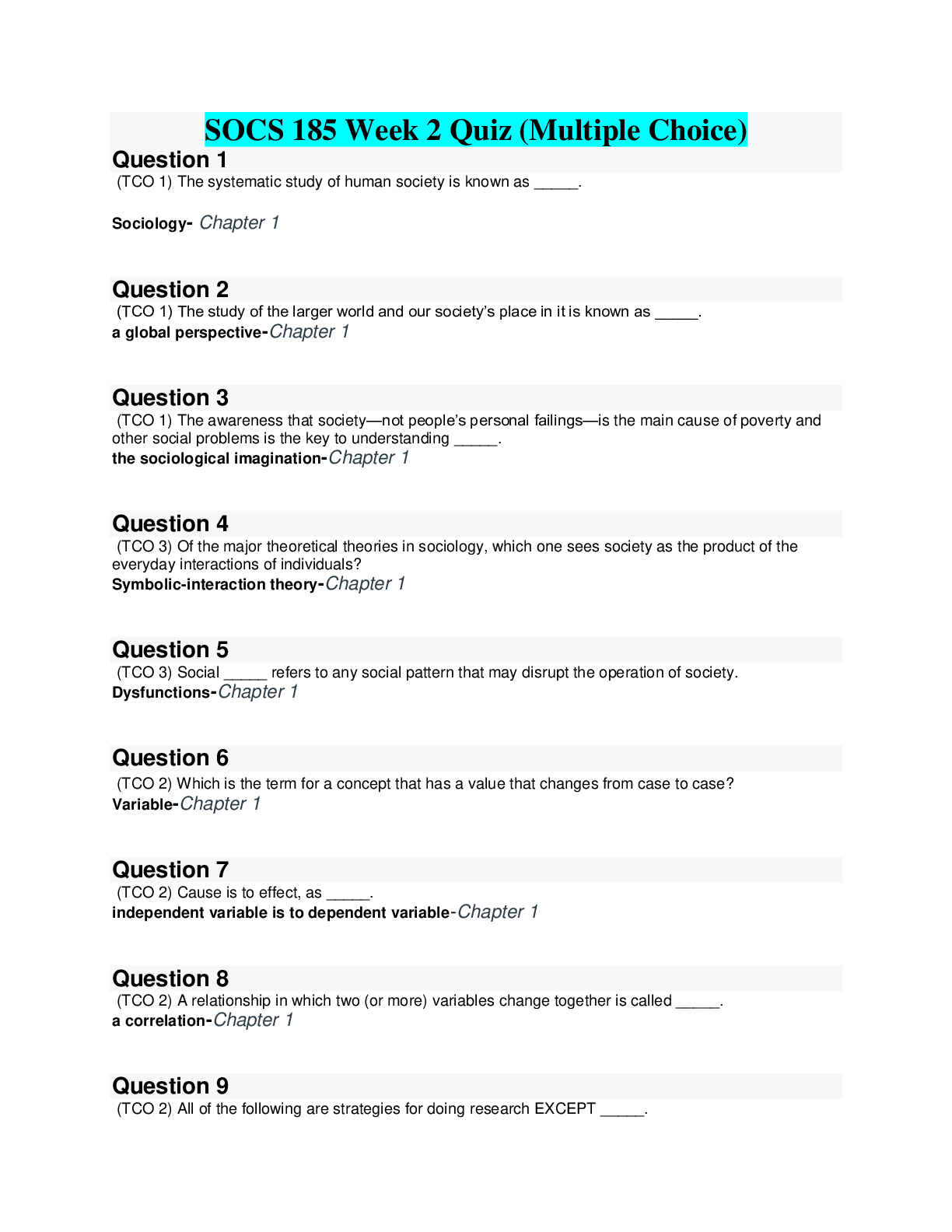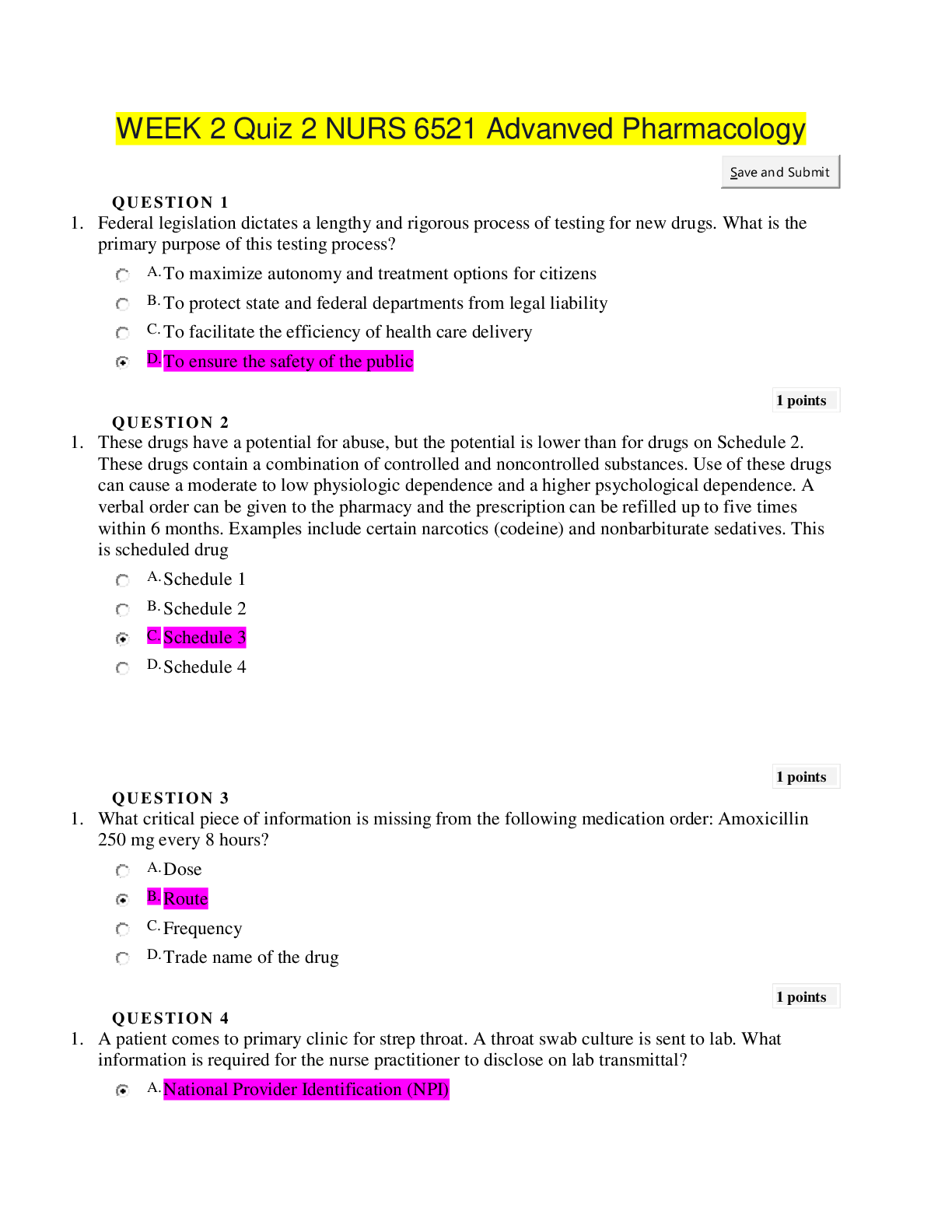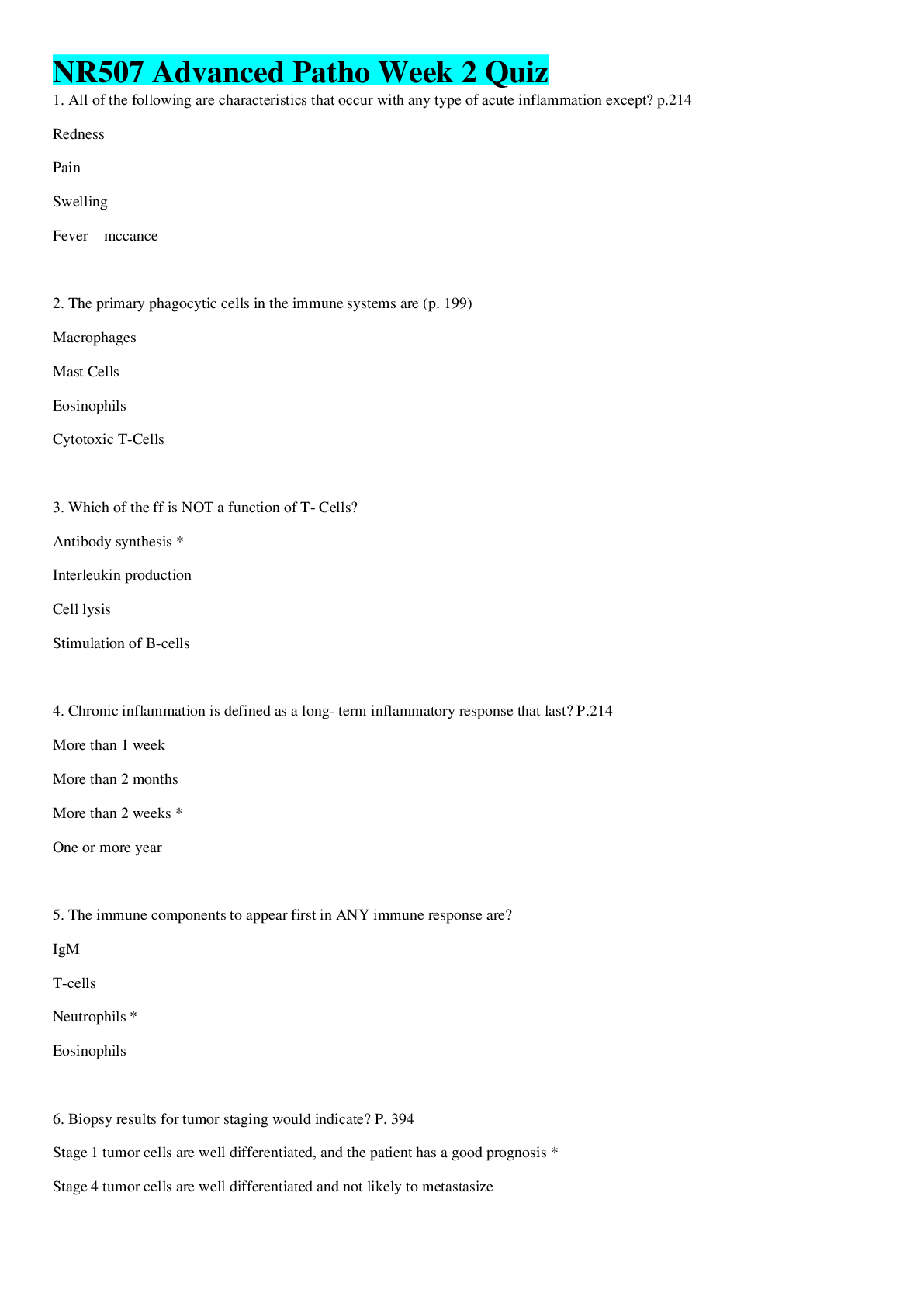NR 507 Week 2 Quiz Answered | Updated Fall 2025/2026.
Document Content and Description Below
NR507 Week 2 Quiz In hyperkalemia, cardiac rhythm changes are a direct result of cardiac cell hypopolarization. cardiac cell repolarization. cardiac cell hyperexcitability. ... depression of the sinoatrial (SA) node. Question 2 Physiologic pH is maintained around 7.4 because bicarbonate (HCO3) and carbonic acid (H2CO3) exist in a ratio of 1:20. 20:1. 10:2. 10:5. Question 3 Chvostek sign and Trousseau sign indicate hypokalemia. hyperkalemia. Correct! hypocalcemia. hypercalcemia. Question 4 Which are indications of dehydration? Polyuria and hyperventilation Muscle weakness and decreased deep tendon reflexes Decreased hemoglobin and hematocrit Tachycardia and weight loss Question 5 How does the loss of chloride during vomiting cause metabolic alkalosis? Loss of chloride causes hydrogen to move into the cell and exchange with potassium to maintain cation balance. Loss of chloride stimulates the release of aldosterone, which causes the retained sodium to bind with the chloride. Loss of chloride causes retention of bicarbonate to maintain the anion balance. Loss of chloride causes hypoventilation to compensate for the metabolic alkalosis. Question 6 Water movement between the intracellular fluid compartment and the extracellular compartment is primarily a function of You Answered antidiuretic hormone. hydrostatic forces. plasma oncotic pressure. osmotic forces. Question 7 At the arterial end of capillaries, fluid moves from the intravascular space into the interstitial space because the capillary hydrostatic pressure is higher than the capillary oncotic pressure. interstitial hydrostatic pressure is higher than the capillary hydrostatic pressure. You Answered capillary oncotic pressure is lower than the interstitial hydrostatic pressure. interstitial oncotic pressure is higher than the interstitial hydrostatic pressure. Question 8 In ARDS, alveoli and respiratory bronchioles fill with fluid as a result of the increased capillary hydrostatic pressure that forces fluid into the alveoli and respiratory bronchioles. inactivation of surfactant and the impairment of type II alveolar cells. You Answered increased capillary permeability, which causes alveoli and respiratory bronchioles to fill with fluid. compression on the pores of Kohn, thus preventing collateral ventilation. Question 9 _____ is a fulminant form of respiratory failure characterized by acute lung inflammation and diffuse alveolocapillary injury. Pulmonary emboli Acute respiratory distress syndrome (ARDS) Acute pulmonary edema Pneumonia Question 10 Clinical manifestations that include unexplained weight loss, dyspnea on exertion, use of accessory muscles, and tachypnea with prolonged expiration are indicative of chronic bronchitis. pneumonia. emphysema. asthma. . Question 11 Pulmonary edema usually begins at a pulmonary capillary wedge pressure or left atrial pressure of _____ mm Hg. 10 30 40 20 Question 12 Kussmaul respirations may be characterized as a respiratory pattern with alternating periods of deep and shallow breathing. commonly observed in pulmonary fibrosis. commonly observed in chronic obstructive pulmonary disease. with a slightly increased ventilatory rate, large tidal volumes, and no expiratory pause. Question 13 Which inflammatory mediators are produced in asthma? Lymphokines, serotonin, and prostaglandins Bradykinin, serotonin, and neutrophil proteases Neutrophil proteases, bradykinin, and histamine Histamine, prostaglandins, and leukotrienes Question 14 Which pleural abnormality involves a site of pleural rupture that act as a one-way valve, permitting air to enter on inspiration but preventing its escape by closing during expiration? Secondary pneumothorax Spontaneous pneumothorax Tension pneumothorax Open pneumothorax Question 15 In tuberculosis, the body walls off the bacilli in a tubercle by stimulating phagocytosis by neutrophils and eosinophils. formation of immunoglobulin G to initiate the complement cascade. Correct! apoptotic infected macrophages that activate cytotoxic T cells. macrophages that release TNF-α. Question 16 Dyspnea is not a result of fatigue of the intercostal muscles and diaphragm. You Answered decreased pH, increased PaCO2, and decreased PaO2. decreased blood flow to the medulla oblongata. stimulation of stretch or J-receptors. Question 17 Clinical manifestations of pulmonary hypertension include dyspnea on exertion and paroxysmal nocturnal dyspnea. peripheral edema and jugular venous distention. productive cough and rhonchi bilaterally. systemic blood pressure greater than 130/90. Question 18 High altitudes may produce hypoxemia through diffusion abnormalities. hypoventilation. shunting. decreased inspired oxygen. The first factor is the presence of adequate oxygen content of the inspired air. Oxygen content is lessened at high altitudes. Question 19 The release of fibroblast growth factors affects ARDS by causing disruption of alveolocapillary membrane. pulmonary fibrosis. atelectasis and decreased lung compliance. pulmonary hypertension. Question 20 Which of the following statements about the advances in the treatment of RDS of the newborn is incorrect? You Answered Administering glucocorticoids to women in preterm labor accelerates the maturation of the fetus’s lungs. Treatment includes the instillation of exogenous surfactant down an endotracheal tube of infants weighing less than 1,000 g. Supporting the infant’s respiratory function by using continuous positive airway pressure (CPAP). An infant’s respiratory function is supported by using continuous pressure (CPAP). Administering oxygen to mothers during preterm labor increases their arterial oxygen before birth of the fetus. Question 21 Chest wall compliance in infants is _____ in adults. higher than lower than the same as unlike that Question 22 Cystic fibrosis (CF) is caused by a(n) malignancy. infection. autosomal dominant inheritance. autosomal recessive inheritance. Question 23 Which immunoglobulin is present in childhood asthma? IgE IgA IgG IgM Question 24 Which of the following types of croup is most common? Fungal Autoimmune Viral Bacterial Question 25 An accurate description of childhood asthma is that it is a(n) obstructive airway disease characterized by reversible airflow obstruction, bronchial hyperreactivity, and inflammation. pulmonary disease characterized by severe hypoxemia, decreased pulmonary compliance, and diffuse densities on chest x-ray. pulmonary disorder involving an abnormal expression of a protein producing viscous mucus that lines the airways, pancreas, sweat ducts, and vas deferens. obstructive airway disease characterized by atelectasis and increased pulmonary resistance as a result of a surfactant deficiency. [Show More]
Last updated: 7 months ago
Preview 1 out of 10 pages

Loading document previews ...
Buy this document to get the full access instantly
Instant Download Access after purchase
Buy NowInstant download
We Accept:

Reviews( 0 )
$8.00
Can't find what you want? Try our AI powered Search
Document information
Connected school, study & course
About the document
Uploaded On
Nov 11, 2019
Number of pages
10
Written in
Additional information
This document has been written for:
Uploaded
Nov 11, 2019
Downloads
0
Views
140




